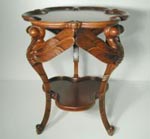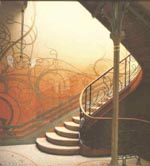|
ART NOUVEAU 1890 - 1914 ART NOUVEAU, French for "New Art" (pronounced New-Vo), spread throughout Europe and major American cities from circa 1890 to World War I, when it fell out of fashion. Appearing just before the Art Deco era it was, in many ways, a response to the Industrial Revolution. Artists, seeing machines and mass production as an enemy of art and design, turned to nature, fantasy, and curvilinear motifs to express their rejection of industry. Art Nouveau artists were among the first to create "art for art's sake" and its influence was found in paintings, architecture, glass, textiles, furniture, silver, china, jewelry, and others. Art Nouveau designers believed that all arts should work in harmony to create a "total work of art". After World War I, the Art Deco style took over and Art Nouveau was soon forgotten. However, it remains one of the most imaginative and intriguing styles in the history of art. After many years, it was discovered in the 1960's and helped pave the way to many forms of modern art.
|
||||||||||||||||||||||||||||||||
|
Art Nouveau has a distinctive visual look. Dynamic, wavy, curved "whiplash" lines in flowing rhythms like those found in Japanese prints characterize much of Art Nouveau. The appearance of motion, movement and abstraction of the natural world allowed for remarkable freedom. Natural forms could be twisted, elongated, and curved to the spatial requirements of any composition. Flowers, birds, dragonflies, spider webs, and especially the female form were favorite motifs. The motifs became more and more abstracted to the point where artists were no longer trying to copy nature exactly, but rather create their own artful interpretation of it. This distinction marks the difference between Art Nouveau and that which came before it.
|
|
||||||||||||||||||||||||||||||
|
Glasswork and stained glass art achieved new prominence during the Art Nouveau period. Louis Comfort Tiffany (1848 - 1933), was the greatest practitioner of the stained glass art form, and he inspired a whole generation of artisans. Some of Tiffany's most inventive designs were his metalwork lamps in which glass and bronze were sculpted together to form objects of unbelievable fantasy. It is these lamps that have become synonymous with his last name. The first Tiffany Glass Company was incorporated on December 1, 1885 which in 1900 became Tiffany Studios. Since his death in January 1933, many have followed in his footsteps to recreate high-quality reproductions of his original glasswork designs.
|
|
||||||||||||||||||||||||||||||
|
A major objective of Art Nouveau was to create a sense of unity in all arts. Because of this, many artists worked in several different fields, becoming Renaissance men and women of their generation. Emile Galle (1846 - 1904), one of the most influential forces of the time studied art, botany, philosophy, glassmaking, and furniture design. Gustav Klimt (1862 - 1918), an Austrian symbolist painter and one of the best-known artists of the period, works included paintings, murals, and sketches. His painting "The Kiss" is among the most recognizable of that time. Artists like Henry Van de Velde, Victor Horta, Joseph Olbrich, Jose Hoffman, and other led the way in architecture creating designs and buildings with all-encompassing artistic visions.
|
|
||||||||||||||||||||||||||||||
|
Today, in the modern era, the Art Nouveau movement is often overshadowed by the Art Deco period that followed. As to why the Art nouveau style came and went so fast, much like a fad, is subject to debate. Unarguably though, the effect of World War I on the world as a whole temporarily stifled many conveniences of the time as rationing and world hardships came into play. In addition, designing buildings in which every room, every piece of furniture, and every detail had to be coordinated demanded an enormous amount of time and money. In short, the architectural style was very impractical and could not sustain itself for long. Art Nouveau exploded on the European and American stage in a flurry and just as quickly disappeared, but left behind some of the most remarkable works of art. Many of the artists, including those most well know at the time, remained active and did go on to participate in the Art Deco movement of the 1920's and 1930's. However, the attempt to maintain beauty, craftsmanship, and art in it's natural and abstracted states were never quite captured again in the modern world of machines, mass production, and industry.
Art Nouveau Links -
|
|
|
|
|
|||||||||||||||||||||||







